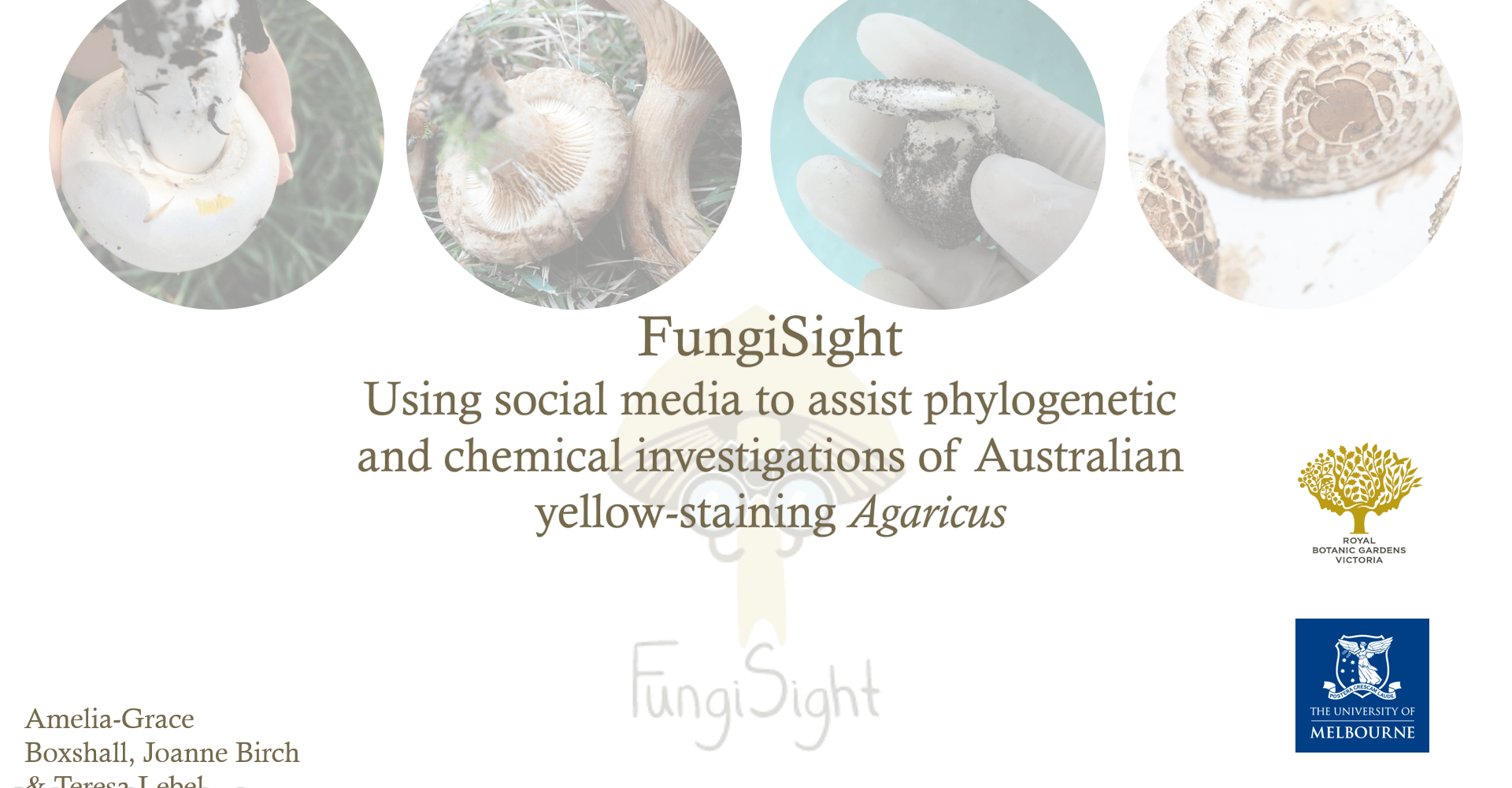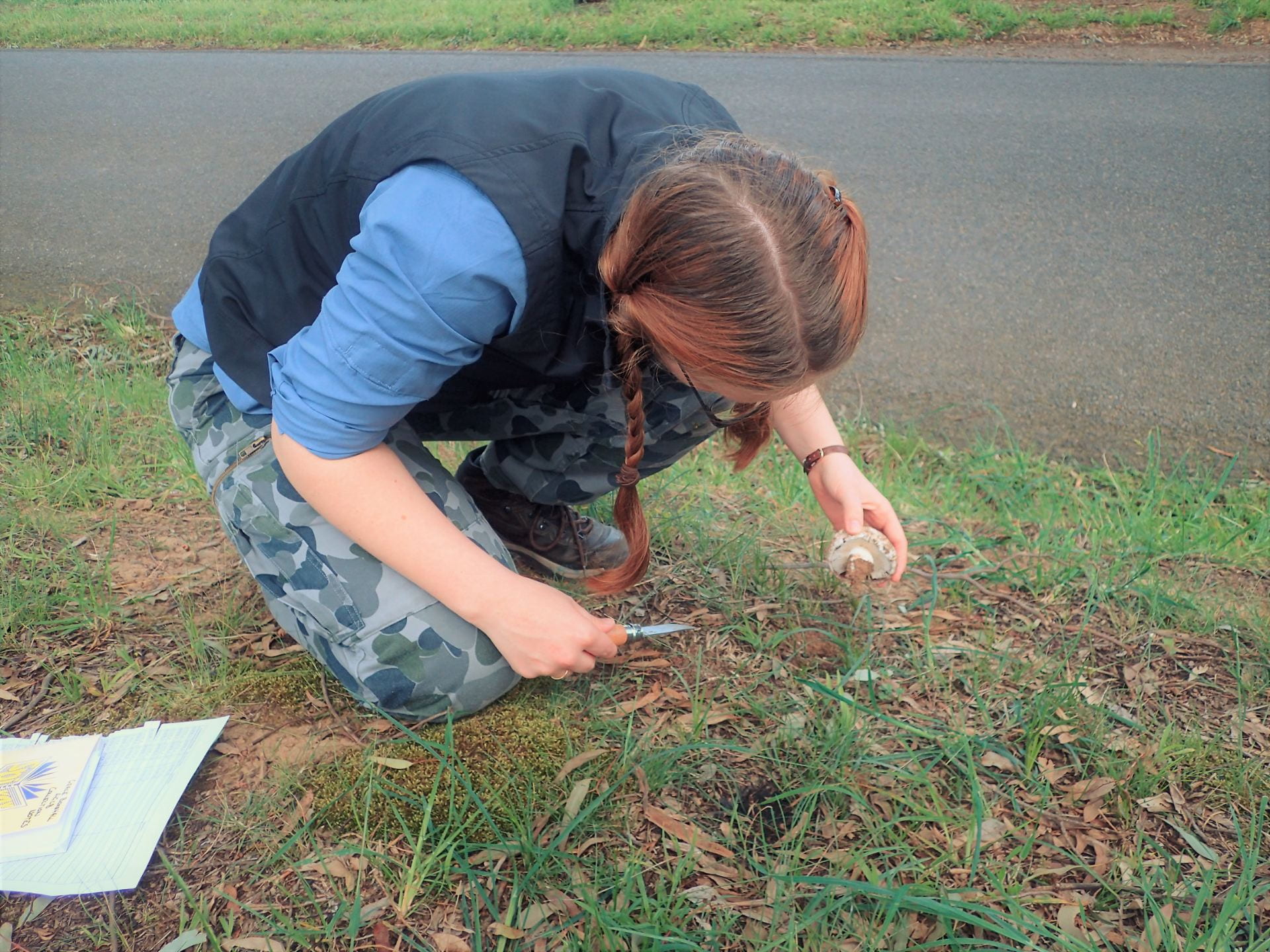
Feature Friday: FungiSight
This week I had a chat with another of our amazing former students about her SciComm work since studying with us. Today I am proud to introduce Grace, a peer-student from my time studying Communication for Research Scientists.
Grace spent 10 years towards becoming a vet, until she discovered botany during her undergrad. This is where she discovered mycology – the branch of biology that is all about fungi. She did her Bachelor of Science with plant science as her major, then Master of Science in Bioscience at the University of Melbourne. For her Masters research, she studied mushroom toxicity and evolution. She was researching Agaricus mushrooms, and required fresh specimens. Unfortunately for Grace, these mushrooms aren’t easy to predict when and where they will be fruiting. So she started a facebook page called FungiSight for the general public to tip her off when and where they saw these mushrooms so she could go and collect them.

“I put up “Wanted” posters all over uni with the Facebook page and email address for people to contact me. I still sometimes get people recognising me from those posters. The funniest interaction I’ve had was when my mum called me from a mushroom stall at a farmer’s market because the lady who ran the stall followed FungiSight and was excited to meet me.”

She wanted a way to thank her community for helping her mushroom-spotting, so she started sharing some of the science as a way to give back.
“The idea was to give people live updates letting them know when their individual sightings were sampled, when I extracted DNA from them, when I had results for that mushroom and when the specimens get incorporated into an herbarium and so on.”
She had a breakthrough when she took our subject, Communication for Research Scientists and found a passion in Science Communication.
“I realised how important sharing science with the world is and became really passionate about it. I also learnt about writing engagingly, and that making regular posts and including a bit of myself as a human would help engage my audience. I started including selfies in posts and talking about myself more. I started sharing regular updates of what I was working on, things that frustrated me, failures and successes. It helped that I started being approached to take part in things, like helping out with a fungi demonstration at a toxicity conference or giving a fungi talk to volunteers at the Victorian Indigenous Nurseries Co-op. FungiSight posts became progress reports but also glimpses into the life and realities of research – because it turns out people don’t have a realistic idea of what researchers do or how long science actually takes. I was able to share some the results of my research as I went too, which were super popular.”

Now it’s more than just mushroom-spotting on FungiSight. Her research has primarily been on poisonous mushrooms, with the goal of reducing the number of people who poison themselves. So naturally, her platform became a way to educate people on which mushrooms they shouldn’t eat.
“There’s been a massive surge in people taking up mushroom foraging during the COVID-19 pandemic – which has corresponded with twice the number of Victorians poisoning themselves by eating the wrong mushroom (insights from the Victorian Poisons Information Centre, comparing this year to last year). I figured now was the time to start posting fungal education posts, like how to tell the difference between edible and poisonous yellow-staining Agaricus, how to identify the lethal Deathcap, and just recently a video introduction to fungal biology.”
“We don’t have a culture of fungal awareness in Australia. We don’t really learn about them at school or from our parents. Universities across Australia have dropped most mycology subjects and the risk is that they’ll drop the mycology components in botany or biology subjects too. It doesn’t really make sense when you consider that the majority of Australia’s fungal biodiversity are undescribed. We honestly have no idea what’s here, how important fungi are for our native plants or animals, which fungi species are going extinct or have already gone extinct, or even which native species are edible or poisonous. I hope that by teaching people about fungi and raising fungal awareness, not only will I inspire people to learn about something cool and teach them how to not poison themselves, I’ll also be able to make a world where I can work in my chosen field.”

As always, I had to ask Grace why she thought Science Communication was important.
“I believe science communication is a political and personal issue. For governments to fund research and for taxpayers to be prepared to contribute towards research, they need to know why it’s important. Young people need to know what science is and involves so they can be inspired to become scientists. But even within science, we need to be able to communicate with each other effectively. We have to be able to give good talks at conferences, write clear grant applications and write research papers. We have to be able to tailor our communication style depending on who we’re talking to so that we can communicate with members of the public, kids, students, our family, our colleagues or the person sitting on the other side of the table at our next job interview. I have to admit that I fall back a lot on science communication skills when I’m teaching.”

“For me, science communication is personal too. In Communication for Research Scientists, we were taught that it’s ok and actually informative to say who did the work. We were taught that you can say things like “I performed x analysis.” To me, that’s incredibly empowering. Suddenly, I exist! I remember when Katie Mack (@astrokatie) gave a guest lecture to us about science and social media. She talked about the importance of not being a science robot on twitter – only ever talking about science all the time. And that made me think that I can be a scientist and a human. If Charles Darwin can write in his journal “but I am very poorly today and very stupid and hate everybody and everything” then maybe I can make mistakes too – and even share them on FungiSight so that the public doesn’t think that you have to be inhuman and invulnerable to be a scientist.”
Later this month, Grace will continue her important research by starting her PhD following on from her Masters project. She’ll be trying to work out which species of Agaricus are here in east coast Australia and New Zealand, discover as many new species as she can, and see how they relate to each other and Agaricus mushrooms throughout the world. She also teaches at uni, demonstrating first and second year practical classes and tutorials. If you don’t see her on a poster, you might see her in class!
– Written by Rosie Arnold, who has a very distinctive memory of Grace’s catchphrase from class:
“If it’s yellow, let it mellow”
Categories